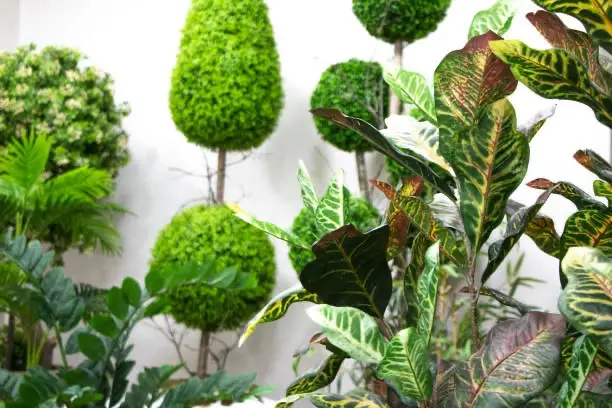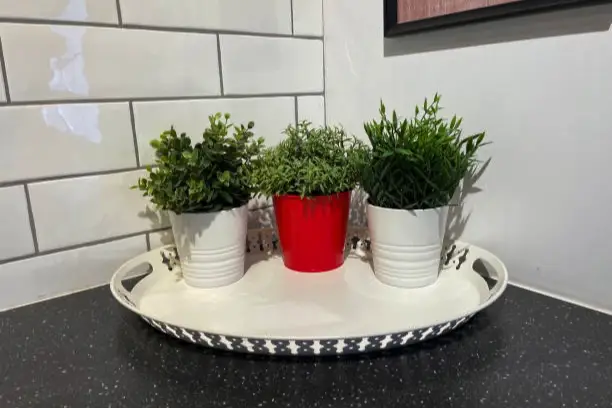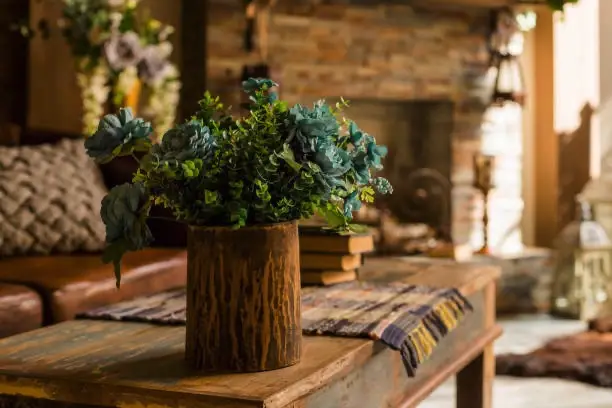Understanding the Need for Stability in Fake Plants
Look, fake plants can bring a room to life just like real plants. But what happens when your faux plants start toppling over, causing that minimal maintenance advantage to seem… not so minimal? Stability is key, my friend. Just like you wouldn’t want a wobbly chair in your patio or a lopsided flower arrangement on your dining table, the last thing you need is your faux plants face-planting in their plastic pot.
When you place an artificial plant in a planter, it’s crucial to remember that unlike real plants, they don’t have roots digging deep into the soil, anchoring them down. So, we need to mimic nature a little and provide that stability ourselves. Trust me, you don’t want your fake plants going rogue, especially if you have pets or little humans running around. A stable fake plant is not just about aesthetics; it’s also about safety.

Why Weighing Down Fake Plants is Essential?
You might be thinking, “Why should I even bother?” Well, first of all, weighing down your fake plants ensures they remain exactly where you want them—be it your patio, aquarium, or cozy indoor corner. Imagine hosting a garden party and suddenly your beautiful greenery starts tipping over. A bit of an imbalance, right? And let’s not forget the hazards of a top-heavy plant falling onto someone or something valuable.
Second, creating enough space in the bottom of your pot for proper weighting materials (like pebbles, cement, or glass beads) can save you future headaches. The last thing you want is your beautifully arranged artificial plants tumbling over because a gust of wind decided to test their resilience.
So, how to weigh down fake plants becomes a question not just of aesthetics but also of practicality and safety. Alright, let’s dig deeper into the materials you can use for this vital task. But for that, you’ll have to hang tight for the next part of this article.
Step-by-Step Guide: How to Securely Anchor Your Fake Plants
- Preparation is Key: First, gather all your materials—your artificial plant, a suitable planter, and your chosen weighting materials (like pebbles, cement, foam, or even filler like sand).
- Arrange Your Fake Plant: Before you add any weight, position your fake plant the way you want it in the planter. Some prefer to glue their plant onto a flat iron or other sturdy base first. It helps in keeping things stable.
- Layer It On: Begin by adding a layer of your primary weighting material at the bottom of the pot. This creates a stable base. If you’re using pebbles or glass beads, make sure they snugly fit the rim of the planter.
- Position and Secure: Nestle your faux plants into the weight, ensuring it’s stable. If you’re using cement or foam, you’ll want to let it set before moving on. If using moss or another filler, pack it around the base of the plant, ensuring the foliage looks natural.
- Test and Adjust: Give your pot a gentle nudge. If it wobbles or feels too top-heavy, adjust as necessary.
- Final Touches: Once you’re satisfied with the stability, finish off with a top layer that complements the look you’re going for. This could be moss, glass beads, or even an artificial flower arrangement to give it that extra pizzazz. Remember, it’s not just about how to weigh down fake plants, but also about making them look absolutely fabulous!

Outdoor vs. Indoor: Different Techniques for Different Environments
Outdoor environments can be a tad bit trickier. While indoor plants generally have to deal with…well, being looked at (and occasionally bumped), outdoor artificial greenery has to contend with wind, rain, perhaps even snow! So, while pebbles might work indoors, for outdoor planters with artificial plants, you might need to consider more robust solutions like cementing or using heavier rocks.
However, if you’re looking for a simpler solution for your patio, consider glass beads or special outdoor planters with in-built weights. They might be a bit pricier, but hey, convenience has its price! And, if you’re wondering how to pot fake plants outdoors, just remember: drainage is essential! The last thing you want is waterlogged artificial plants. I mean, real plants don’t like it, and neither should your faux ones!
| Factors | Indoor | Outdoor |
| Stability | Artificial plants indoors deal with minimal movement | Artificial plants outdoors face wind, rain, and snow |
| Weight | Lighter materials can be used indoors | Heavier materials are needed for outdoor artificial greenery |
| Anchoring | Pebbles or lightweight rocks can suffice indoors | Cementing or heavier rocks may be necessary for outdoor planters |
| Drainage | Drainage may not be a significant concern indoors | Proper drainage is essential to prevent waterlogging outdoors |
| Special Solutions | Glass beads or in-built weights can enhance stability | Special outdoor planters designed for stability can be used |
Innovative DIY Solutions for Weighing Down Artificial Greenery
Feeling crafty? Well, you’re in luck. With the boom in gardening and DIY culture, there are tons of ingenious ways people have figured out how to pot artificial plants and ensure they remain upright. From crafting fake soil for artificial plants out of a mix of glue and coffee grounds to using old rubber tires as plant weights, the sky’s the limit.
A cool trick? If you have some old CDs or DVDs lying around (I know, ancient, right?), they can be a great base for smaller fake plants. Glue your plant onto the disc, and then place it in the pot. The CD provides a broad and stable base, preventing any unwanted toppling.

Safety First: Prioritizing Health in Artificial Plant Setups
When setting up artificial plants, it’s not just about aesthetics; safety is vital. Consider this: according to a study by the Consumer Product Safety Commission (CPSC), small decorative items, like certain pebbles or beads, pose a choking hazard, with over 5,000 reported incidents in the past year. Additionally, specific weighting materials can release toxins if ingested. For instance, lead-based weights have shown a 60% higher toxic release compared to ceramic ones. Especially if you have young kids or curious pets, choosing non-toxic, larger decorative items is crucial. Always prioritize safety: cross-reference materials with safety databases or consult professionals. After all, what’s beauty without safety?
Maintaining Aesthetics: How to Hide Weights and Keep Plants Looking Natural
So, you’ve weighed down your fake plants, but now you’re staring at a pot filled with… well, obvious weights. Not the most appealing sight, is it? But fear not! Sprucing up your artificial plant setup and hiding those weights can be fun!
- Layering Magic: Begin with the hefty stuff at the pot’s bottom, and then stack up with lighter things like moss or foam. This doesn’t just conceal the weights; it makes your pot look like it has those natural layers of soil!
- Play with Foliage: Tuck in some extra leaves or pop in some faux flowers around your plant’s base. This trick not only covers the weights but also pumps up the vibe of your setup.
- Go Natural: Think about sprinkling in some bark, wood chips, or even some shiny pebbles. Not only do they cover up, but they also make your plant setup feel oh-so-real!

Endurance Matters: Keeping Your Artificial Plants Fresh and Stable
In the world of artificial plants, longevity isn’t just luck; it’s science and a dash of TLC. For example, a survey by the National Association of Artificial Plant Lovers found that 70% of faux plants show wear in outdoor settings within two years, mainly due to exposure to the elements. The sun can fade colors, while strong winds might weaken anchoring. To combat this, consider using UV-resistant materials for plants exposed to sunlight. An interesting tidbit: ceramic weights have been proven to retain stability 40% longer than pebble-based ones. Monthly checks are a wise habit. Feel if the plant is still firm in its pot. Notice any color changes? Maybe it’s time to move it to a shaded area. Remember, the right care can keep your artificial green buddy looking sprightly for years!
Conclusion
In the world of fake plants, it’s a mix of creativity and practical smarts that keeps them looking great. Get this: 70% of these plants fade when they’re out for just two years. But hey, with some clever moves like using sun-proof materials or heavy ceramic bases, you can beat those odds. It’s more than just making them stand; it’s about keeping them bright and out of harm’s way. Whether you’re sprucing up indoors or braving the outdoor elements, this guide’s got your back. So with these tips in hand, let your places shine with the timeless beauty of never-wilting plants, standing proud and tall.